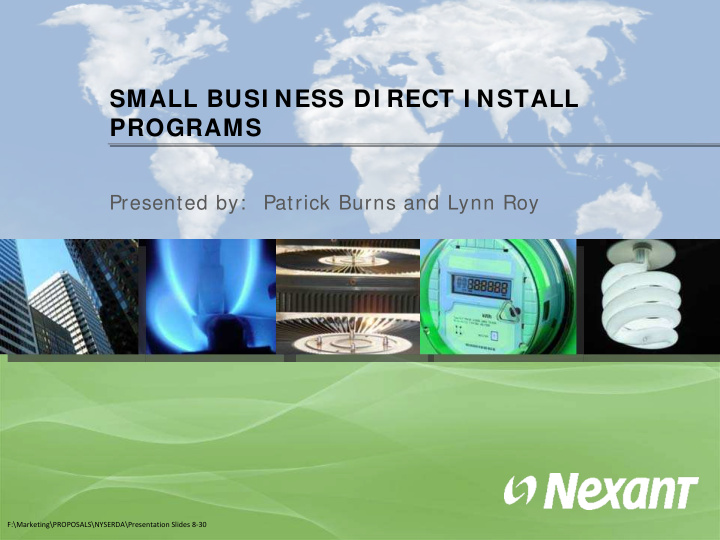



SMALL BUSI NESS DI RECT I NSTALL PROGRAMS Presented by: Patrick Burns and Lynn Roy F:\Marketing\PROPOSALS\NYSERDA\Presentation Slides 8 ‐ 30
W HAT AND W HY? DI D I T W ORK? HOW ? 2
NEXANT, I NC. 17 Domestic Energy Efficiency & Carbon Offices Managem ent ( EE&CM) – Market Characterization – Market Potential Studies – DSM Program Planning, Design, Administration Implementation – Energy Auditing, Commissioning, Recommissioning, Energy Modeling, LEED, M&V 11 International – Impact Evaluations Offices – Database Management Software – Customer Service and Rebate Processing 3
W HAT I S A SMALL BUSI NESS DI RECT I NSTALL PROGRAM? Seeks to provide energy efficiency services and education to harder to reach small business market Provides energy assessment for small commercial facilities Facilitates the direct retrofit installation of energy efficiency measures through program-ready contractors Helps to minimize customer effort and reduce financial barriers by providing direct services and incentives
TYPI CAL PROGRAM PROCESS 5
PROGRAM OUTREACH OPTI ONS Pull (lower cost and likely lower participation) – Direct Mailer – Bill Inserts – Website Information – Chamber of Commerce Push (higher cost and higher participation) – “Door to Door” or “Street Sweeps” – “Contractor in the area” Announcements – Utility Customer Service must be aware of activities to confirm legitimacy
DEFI NI NG CUSTOMER ELI GI BI LI TY ‘Small Business’ eligibility is often established by peak demand or annual energy consumption – Could include premise size or age criteria – Target businesses that do not have formal or significant budgets for energy efficiency and/ or equipment improvements or are not candidates for ESPC. Program can target business sectors, such as: – Retail – Service – Restaurant Consider avoiding businesses with high churn rate, where code requirements may require energy efficient measures and opportunities are minimal.
ENERGY ON-SI TE ASSESSMENT Important “first” interaction between utility representative and customer needs to balance: – Time commitment from customer – Invasiveness vs Thoroughness – Education of customer on holistic energy efficiency opportunities; home and business Conduct on-site audit to determine program and measure installation options and eligibility
ENERGY ON-SI TE ASSESSMENT Utilize standard survey instruments for assessment completeness – Consistent auditing forms – PDA’s Establish a customer installation cost and work order to complete project and identify simple payback – Establish deemed measure performance for uniformity and simplicity 9 9
ENERGY ON-SI TE ASSESSMENT Optional: Provide customer with an understanding of premise energy consumption – Utilization of on-line report printing can keep customer engaged in the program
ENERGY ON-SI TE ASSESSMENT Optional: Gather information about saturations of existing: – Commercial sector composition – End-use prevalence – Equipment efficiency saturations not in program Education Grocery Health Large Office Miscellaneous Restaurant Retail Small Office Warehouse 0% 20% 40% 60% 80% 100% Percent of Fixtures T12 T8 Incandescent CFLs HID Miscellaneous
ENERGY ON-SI TE ASSESSMENT: EFFECTI VE MEASURES Program should include measures that are proven to be cost-effective (TRC> 1.0) and relatively simple to install – Fluorescent Lighting – Lighting Controls – LED exit signs – LED signs – HVAC tune-up – Programmable Thermostats – Refrigeration • Gaskets and Insulation • Door Closures – Water Heating • Equipment upgrade • Pipe Insulation
CUSTOMER FI NANCI NG Several incentive and financing options – No cost to customer for measure installations up to $1,000, $1,500, even $2,500! • Customer can elect to install measures above no cost thresholds. Utility can provide incentives for projects exceeding no cost threshold. – Customer funds 20% to 30% of installation costs • Optional zero-percent financing option recovered through energy bill payments – Tie-in with existing utility incentives Define a stream-lined cost proposal to customer and easy to follow participation process
MEASUREMENT & VERI FI CATI ON Conduct inspections on small sample of projects to confirm proper installation procedures Provide higher sampling rates for energy efficiency measures that have higher uncertainty of savings – Savings from thermostats and lighting controls can be defeated. – CFL saving persistence can be lower. Reduce sampling rates for measures that have low uncertainty of savings, such as – Fluorescent lighting – LED exit signs Consider baseline inspections to verify savings. Lighting loggers to determine operating hours can be useful to calibrate deemed savings.
LI GHTI NG LOGGER DATA 15
EVALUATI ON LESSONS LEARNED Program included: – Linear fluorescent measures – CFL measures – LED exit signs – Water heating aerators – Water heating insulation Up to $1,000 of no cost installed measures – Customer can purchase program measures for 100% of measure installation cost over $1,000 Program participants could not participate in other utility DSM programs for 2 years Program participation percentages: – 99.5% linear fluorescent – 30% CFL measures – 16% Exit signs – 1.5% Water heating measures
EVALUATI ON LESSONS LEARNED 2,420 kWh saved per customer Average implementation cost was $1,008 – 25% exceeded no cost cap Evaluated SBDI program had TRC = 2.30, PAC = 1.34 Evaluated Net-to-Gross is 95% Program had an evaluated peak demand coincidence of 81% Operating hours for small businesses were lower than California DEER deemed operating hours, 80% of deemed values Baseline equipment installation tracking can be difficult with many possible equipment types – In some cases like for like installations have occurred CFL measures can have poor persistence
SBDI PROGRAM BENEFI TS Reducing overhead costs for small businesses! JOBS, JOBS, JOBS – Program has measurable impact on job creation High incentives can lead to high participation in hard to reach market – Buoy DSM portfolio targets when CFL baselines increase Proper program design can have TRC and PAC over 1.0. 18
QUESTI ONS? 19
Recommend
More recommend